Conquest of Buda Castle Mystery Cache
-
Difficulty:
-

-
Terrain:
-

Size:  (micro)
(micro)
Please note Use of geocaching.com services is subject to the terms and conditions
in our disclaimer.
The Game
I would like to invite you to a game in the Buda Castle. The goal of this game is to find the spots where the photos are taken and to answer the questions about them. The coordinates of the cache will work out from your answers finally.
The photos are taken mostly at well-known points of the Buda Castle, but hopefully you will not be able to identify them immediately. :) So, you have to take a big walk in the Castle. Be prepared for a 2-3-hour walking and keep your eyes open! :)
Some of the gates to the cache and some spots can be approached only at open hours between 15 Apr - 15 Oct: Mon-Sun 6-24 and 16 Oct - 14 Apr: Mon-Sun 6-22, but most of the spots can be approached without time limitation. I suggest you check the open hours of a gate on the information board near to the gate before entering it close to 22/24 hours.
GPS signal is very poor close to the cache.
The cache is a plastic disk with ~7 cm diameter and ~2 cm height. Coins and small TBs can be placed in it, but not too many of them at the same time.
There is no pen in the cache, so bring your own!
The hiding place is very busy in the day time. Watch out for muggles!
The cache can be found at N47° ab.cde E019° 0w.xyz.
You can check your answer on Geochecker.com.
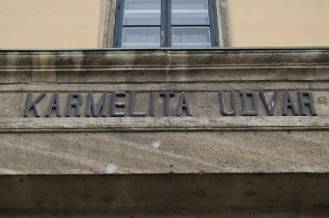
a = Number of immobile trees can be found at the courtyard of “Karmelita udvar”.

b = Number of saints can be found on the object where the photo is taken.
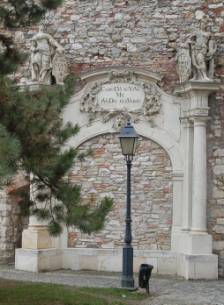
c = Number of lampposts are standing at the courtyard where the photo is taken.
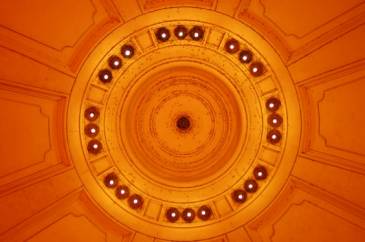
d = Number of beasts are guarding the object can be seen on the photo. (Take into consideration that this photo was taken in the dark hours.)

e = Number of bells are placed in one column close to this object.

w = Number of green shrubs can be found at the courtyard where the photo is taken.-1
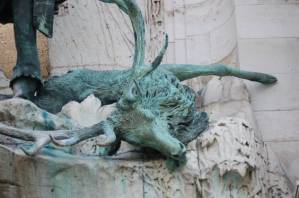
x = Number of hunting horns can be found at the statue where the photo is taken. (Go round the statue!)
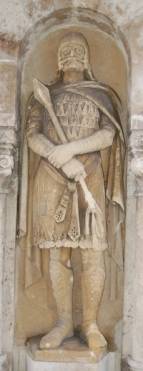
y = Number of solders are guarding the place where the photo is taken.
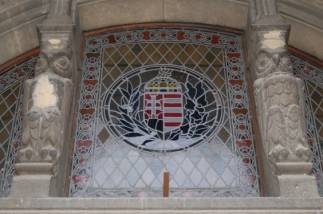
z = Number of asymmetric columns (thick cylinder on taller block) are holding the arches of building where the photo is taken.
BONUS QUEST:
The solution of this quest is not needed for finding the cache. It is only an extra challenge. It is only for fun. :)
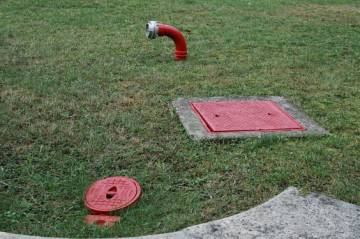
Find this object in the Castle, take a photo of it with you and upload the photo.
Have a good time!
Buda Castle
Buda Castle (the Castle Quarter) on the Castle Hill stands 180 m above the sea level. It is around 1.5 km long and in places it is 500 meters wide. It boasts three churches, six museums, many historical buildings, monuments, streets and squares, a theatre, four hotels, numerous atmospheric restaurants, cafés, galleries and gift shops. Breathtaking panoramas open from the Fishermen's Bastion and the promenade in front of the Royal Palace.
Getting to Buda Castle
The best way to get up Buda Castle is to take the funicular (Sikló) next to the Tunnel. The track is 95 meters long, 48% steep and offers an astonishing panorama.
Tickets (prices in 2009):
- single ticket: 840 HUF
for kids between 3-14 years of age: 520 HUF
- return ticket: 1450 HUF
for kids between 3-14 years of age: 940 HUF
- Children under 3-year-old and disabled people can travel on the cable car free of charge.
Operating hours of the funicular: 7.30-22.00. It is closed on Monday of odd weeks because of service. The cable car runs constantly during peak time and at max 10-minute intervals during less busy periods.
Other option is to take the bus 16A (also called as Várbusz (Castle bus)) departs from Moszkva tér (Moscow square), or take the bus 16 departs at the Buda end of the Chain Bridge.
Brief History of Buda Castle
The Castle Hill was first populated and surrounded by walls by King Béla IV after the Mongol attack of 1241-1242, which devastated most of Hungary. By the 14th century, it had just over 8,000 inhabitants.
During the 15th century, under the rule of King Matthias, Buda became one of Europe’s most influential cities. He had the fortress enlarged and transformed to a palace.
The Turks invaded Buda Castle in 1541 and ruled it until 1686 when the Austrian Habsburgs and their allied armies took back the hill. The siege left Castle Quarter in ruins. After the Turks, the Habsburgs moved here. Reconstructions began immediately, following the old street layout. The Castle became a government district.
The current elegant Baroque appearance was formed by the mid 18th century.
The battles in WWII ruined the place again. Reconstructions after the war rebuilt Buda Castle Quarter: the buildings by the Habsburgs were reconstructed, the street pattern of the medieval city has been kept and much of the architectural features have been restored.
In our days, people still live here. Cars are banned from Buda Castle: only people who live or work in the area, guests of the Hilton Hotel, taxis and the Várbusz have permission to drive up here.
Bécsi kapu tér (Vienna Gate Square)
The only existing old town-gate: the Vienna Gate. This is the northern gate of the Quarter, all four roads that run along the hill converge here. From the top of the gate, you get a beautiful view of the Buda Hills and you can see the imposing Budapest Parliament from an unusual angle.
Bécsi kapu tér served as a Saturday Market in the Middle Ages for non-Jewish merchants.
The large building of Országos Levéltár (National Archives) towers the northern end of the square.
The so-called Europe Grove is to the right of the Gate. Mayors of all the major European cities planted rare trees here in 1972. You'll find about 16 types of trees here, for example Turkish hazel and Japanese cherry.
Kapisztrán tér
On the corner of Kapisztrán tér and Országház utca, the St. Mary Magdalene Tower stands. It was a Franciscan church in medieval times. Under the Turkish rule this was the only Christian church, the Turks converted all the other churches into mosques. The church was destroyed in World War II, only its 15th century tower survived the bombings.
In the north-western part of the Castle Quarter is the Hadtörténeti múzeum (Museum of Hungarian Military History), whose collection numbers over 28,000 items from the 1490's to the present time.
From here, it is a short walk to Táncsics utca, where the Museum of Music History has a permanent Béla Bartók Memorial Exhibition on display in a Neo-Baroque house.
Szentháromság tér (Holy Trinity Square)
Here stand the Old Town Hall of Buda, which lost its original function when Buda, Pest and Óbuda were united in 1873. In its cellar the Hungarian House of Wines awaits its guests with a full representation of Hungarian winemakers, and offers a palette of services for visitors, such as wine tasting - both for groups and independent travelers.
The Baroque-style Holy Trinity statue, in the middle of the square, commemorates the victims of the 1691 plague epidemic.
Mátyás templom (Matthias Church)
The right side of the square is dominated by the Mathias Church, surrounded by the turrets and walkways of the Fishermen's Bastion. The church is officially called The Church of Our Lady, and served as a coronation church from the 16th century on. Its vast ecclesiastical collection and treasury is open for visitors. During the centuries, the church underwent several major transformations, the first of which was the addendum of the Mária-kapu (Mary-gate), and in 1470, the 60-metre south side tower, with the King's raven ensign, was erected. During the Turkish occupation, the church was turned into a mosque and its walls were whitewashed; in the 17th century, it was again rebuilt in Baroque style. Today's Mathias Church is the result of a major renovation between 1895 and 1903, by star architect of the age Frigyes Schulek. The frescoes are the works of famous Hungarian artists such as Károly Lotz, Bertalan Székely and Mihály Zichy.
Halászbástya (Fishermen’s Bastion)
The Fishermen's Bastion was built simultaneously with the last major renovation of the Mathias Church, in an unique architectural unison. The Bastion has seven turrets, each symbolizing a Hungarian tribal leader. Its foundation is a part of the former medieval fortified defensive wall. The structure has never served defence purposes, only that of decoration. Its approximate location gave home to a huge fish and grocery market in the Middle Ages, and in the Water Town directly below the walls, most of the population made a living from fishing - hence the name, paying tribute to the fishermen. The structure has two long, ornate staircases leading up to it: the central staircase is called the Schulek-lépcso (Schulek Staircase), and the hidden tunnel-like one connects a Water Town street with the southernmost turret is called the Jezsuita-lépcso (Jesuit Staircase).
On the medieval Úri utca, a brown flag marks the entrance to the Castle Labyrinth, which is a vast system of natural caves formed by geothermic activity, enhanced by man.
Dísz tér
As we walk to the south from Szentháromság tér on Tárnok utca, the Arany Sas Pharmacy Museum, built in 1745, comes to view. At, which is the southern gate of the residential part of the Castle Hill, stands the ruinous building of the former National Defence Command. There are large-scale excavations going on behind the square, where remnants of the previous castles from the Middle Ages are being unearthed.
Diagonally across the flagpole-lined esplanade is the Sándor Palace, which is the Hungarian President's official residence. Built in 1806, but horribly damaged during WWII. It was beautifully renovated in 1989. This is the upper station of the funicular railway, the Budavári Sikló.
Royal Palace
The original Royal Palace was destroyed and rebuilt many times. Its history is very much like that of the Matthias Church's. King Béla IV started building a palace in the 13th century after the Mongol invasion. The original Gothic Palace was built and expanded for 300 years.
The golden era of the palace was under the rule of King Matthias (1451-90). It was totally destroyed in 1686 when the Habsburg army liberated Buda from the Turkish occupation. The Habsburgs built a completely new, small Baroque palace in the beginning of the 18th century. It was damaged again in the 1848-49 War of Independence. The following reconstruction almost doubled it in length at the end of the 19th century (now it's 304 m long) and a large wing was attached to the back. In 1945 it was the last defense of the German troops in Budapest. Post-war reconstruction revealed Gothic and Renaissance foundations that have been incorporated in the building during the works. Thus the Palace is a mix of architectural styles.
Today the Palace houses two museums (Budapest History Museum and Hungarian National Gallery) and the National Széchenyi Library.
Map of Castle District
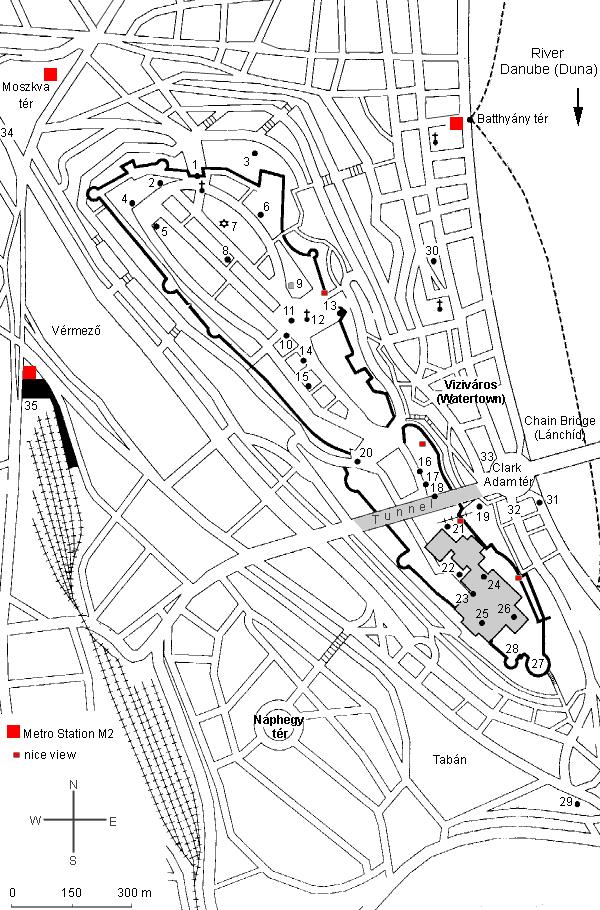
1. Vienna Gate (Bécsi kapu)
2. National Archives of Hungary (Magyar Országos Levéltár)
3. Europa Grove (Europa Liget)
4. Museum of Military History (Hadtörténeti Múzeum)
5. Church of St. Mary Magdalene (Mária Magdolna templom)
6. Museum of Music History (Zenetörténeti Múzeum)
7. Medieval Jewish Prayer House (Középkori Zsidó Imaház)
8. Hungarian Museum of Commerce and Catering (Kereskedelmi és Vendéglátóipari Múzeum)
9. Hotel Hilton
10. Old Town Hall of Buda (Buda Városháza)
11. Holy Trinity Satue (Szentháromság szobor)
12. Matthias Church (Mátyás templom)
13. Fisherman`s Bastion (Halászbástya)
14. Golden Eagle Pharmacy Museum (Arany Sas Patikamúzeum)
15. Buda Castle Labyrinth (Budavári Labirintus)
16. Karmelita Courtyard (Karmelita Udvar)
17. Castle Theatre (Várszínház)
18. Sándor Palace (Sándor palota)
19. Buda Castle Funicular (Budavári Sikló)
20. Fehérvári Gate and Round Bastion (Fehérvári Kapu és Rondella)
21. Habsburg Gate and Turul bird (Habsburg Kapu és Turul madár)
22. Hunyadi Courtyard and Matthias Fountain (Hunyadi udvar és Mátyás kútja)
23. Lions Courtyard (Oroszlanos udvar)
24. Hungarian National Gallery (Magyar Nemzeti Galéria)
25. Széchenyi National Library (Országos Széchényi Könyvtár)
26. Budapest History Museum (Budapesti Történeti Múzeum)
27. Big Round Bastion (Nagy Rondella)
28. Mice Tower and Ferdinand Gate (Buzogánytorony és Ferdinánd kapu)
29. Rác Baths (Rácfürdõ)
30. Concert Hall "Budai Vigadó" (Budai Vigadó)
31. Tram #19 & #41 (19-es és 41-es villamos)
32. Bus #86 (86-os busz)
33. Bus #16 (16-os busz)
34. Bus #16A (16A busz)
35. Déli Railway Station (Déli Pályaudvar)
Additional Hints
(Decrypt)
Ivraan Tngr -> mrolnqkpj -> pnpur: gbc bs jnyy, yrsg fvqr bs svefg tnc